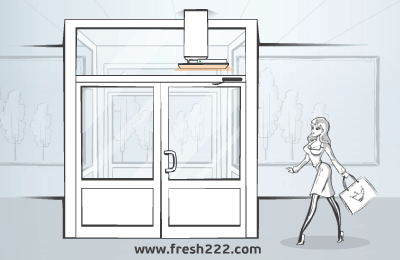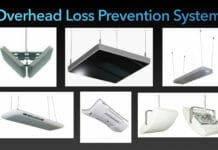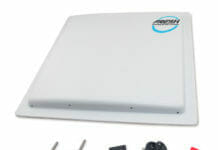Retail anti-theft systems are security solutions designed to prevent theft in retail stores. They typically use a combination of technologies, including electronic article surveillance (EAS) systems, security cameras, and other monitoring and tracking tools, to detect and deter theft.
What Are Retail Anti Theft Systems
Electronic article surveillance (EAS) systems are the most common type of retail anti-theft system. These systems use small security tags or labels that are attached to merchandise, and detection antennas at store exits that can detect when a tag is passing through. If an active tag passes through the antenna, an alarm will sound, alerting store personnel to a potential theft. In addition to EAS systems, retailers may also use security cameras and other monitoring tools to deter theft and monitor store activity. These systems can provide real-time video footage of the store, which can be monitored remotely by store personnel or security staff.
Retail anti-theft systems may also incorporate data analytics and automation tools, such as RFID and IoT technologies, to provide real-time tracking and monitoring of inventory and customer behavior. This allows retailers to quickly identify potential theft incidents and patterns of suspicious behavior, and to take appropriate action to prevent loss. Retail anti-theft systems are a critical component of modern retail security, helping retailers to prevent loss and protect their merchandise while also providing a safe and secure shopping experience for customers.
Retail anti-theft systems and software developed by FRESH USA have the best solutions for retail operators. For more information, follow the link about theft prevention systems
Anti-Theft Systems For Retail Shops And RFID Technology
Retail anti-theft systems can be enhanced through the use of RFID UHF technology, which can provide more comprehensive and accurate monitoring of inventory and customer behavior.
You can order a reliable and advanced retail theft prevention systems from Fresh USA, click below.
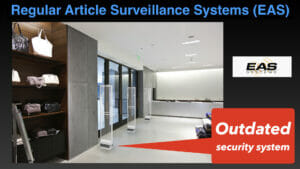
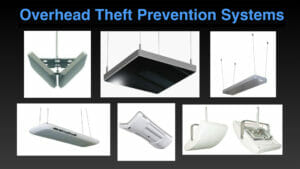
RFID UHF technology uses radio frequency identification (RFID) tags* to track individual items and provide real-time information about their location and status. These tags can be integrated into the store’s inventory management system, allowing retailers to monitor stock levels, track inventory movements, and identify potential theft incidents in real-time. By using RFID UHF technology, retailers can also gather data on customer behavior, such as the time spent in specific areas of the store, and use this information to identify potential theft incidents. RFID UHF tags can also be used to track high-value items or items that are frequently targeted by thieves, making it easier to identify and prevent theft.
RFID UHF technology can also enhance the customer experience by enabling retailers to provide faster and more accurate checkout processes. RFID tags can be used to automatically identify items at the point of sale, reducing the need for manual scanning and speeding up the checkout process. Integrating RFID UHF technology into retail anti-theft systems can provide more comprehensive and accurate monitoring of inventory and customer behavior, helping retailers to prevent loss and provide a better shopping experience for customers.
* Retail theft prevention tags, watch the VIDEO
How RFID And IoT Technologies Work With Retail Anti-Theft System
RFID and IoT technologies can work together with retail anti-theft systems to provide real-time tracking and monitoring of inventory and customer behavior.
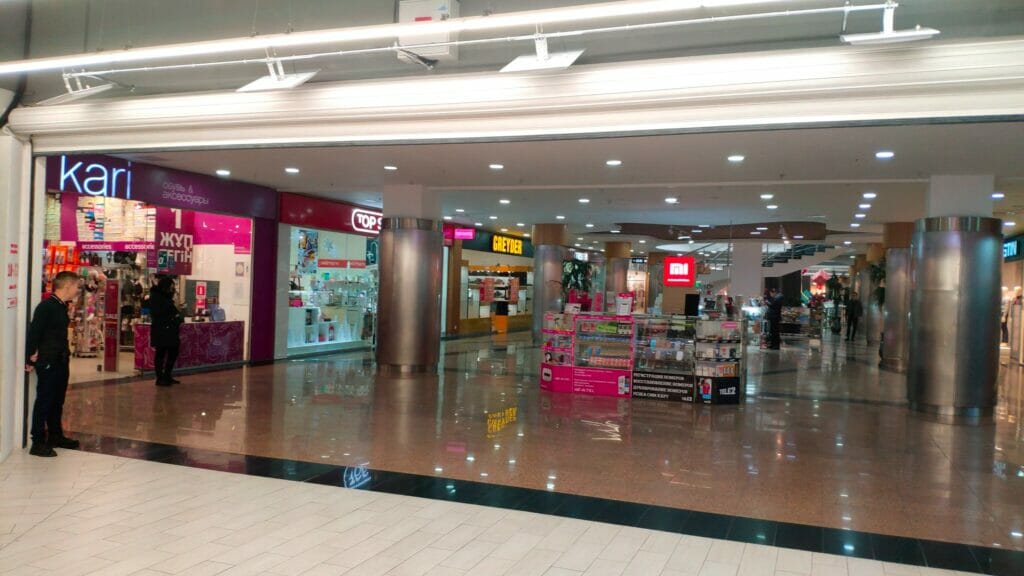
Here’s how they work together:
- RFID technology uses radio frequency identification tags or labels that are attached to merchandise or integrated into product packaging. These tags contain a unique identifier that can be detected and read by RFID readers or antennas, allowing retailers to track individual items and monitor inventory levels.
- When integrated with retail anti-theft systems, RFID tags can provide real-time monitoring of inventory movements, allowing retailers to identify potential theft incidents in real-time. RFID readers or antennas can be placed at various locations within the store, including at entry and exit points, to track the movement of merchandise and detect any unauthorized removal of items.
- IoT technology can enhance the functionality of retail anti-theft systems by providing real-time data analytics and automation tools. IoT sensors can be used to collect data on customer behavior, such as the time spent in specific areas of the store or the frequency of visits, and this data can be analyzed in real-time to identify potential theft incidents or suspicious behavior.
For example, if a customer spends an unusually long time in a particular section of the store or repeatedly visits an area where high-value items are kept, this could indicate potential theft activity. IoT sensors can also be used to monitor the performance of retail anti-theft systems, ensuring that they are functioning properly and alerting store personnel to any issues or malfunctions.
When Choosing Retail Anti-Theft Solutions.
When choosing a retail anti-theft system, there are several key factors to consider:
- Compatibility with your store layout and merchandise: The anti-theft system should be compatible with your store’s layout and merchandise. For example, some systems may not be suitable for stores with high ceilings or stores with a large number of metal objects, which can interfere with the system’s sensors.
- Detection range and accuracy: The anti-theft system should have a wide detection range and high accuracy to ensure that potential theft incidents are detected and deterred. The system should also be able to differentiate between genuine alarms and false alarms, to avoid inconveniencing customers and staff.
- Ease of use and maintenance: The anti-theft system should be easy to use and maintain, with clear instructions and minimal maintenance requirements. The system should also be easy to integrate with your store’s existing security measures and IT infrastructure.
- Cost-effectiveness: The anti-theft system should be cost-effective and provide a good return on investment. This includes not only the cost of the system itself but also the ongoing maintenance and operational costs.
- Customer experience: The anti-theft system should not negatively impact the customer experience. It should be unobtrusive and not impede the flow of customers through the store.
By considering these factors when choosing a retail anti-theft system, retailers can select a system that is effective, efficient, and compatible with their store’s layout and merchandise, while also providing a positive customer experience.
Use of Long-Range Wireless Technologies In The Theft Prevention Systems
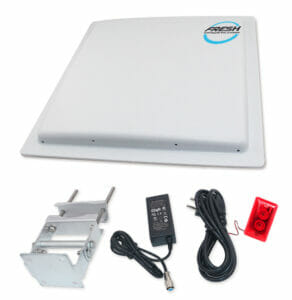
Theft prevention systems manufactured by FRESH USA have been tested for many years of use around the world and work perfectly in all weather conditions. The retail anti-theft systems developed by Fresh USA uses only contactless technologies such as Wi-Fi, 4G / LTE and RFID UHF long range distance with a frequency of 860MHz – 960MHz. You can integrate the theft prevention software with other third-party software or your ERP system using a SQL database or deploy a Web-service.
Any RFID theft prevention system from Fresh USA is Your reliable choice!
The main advantage of the retail anti-theft systems with RFID UHF technology is the high read range, which allows for efficient and convenient prevent of thefts without the need for physical contact or line-of-sight communication.
Overall, RFID and IoT technologies can enhance the effectiveness of retail anti-theft systems by providing real-time tracking and monitoring of inventory and customer behavior, allowing retailers to prevent loss and provide a better shopping experience for customers.
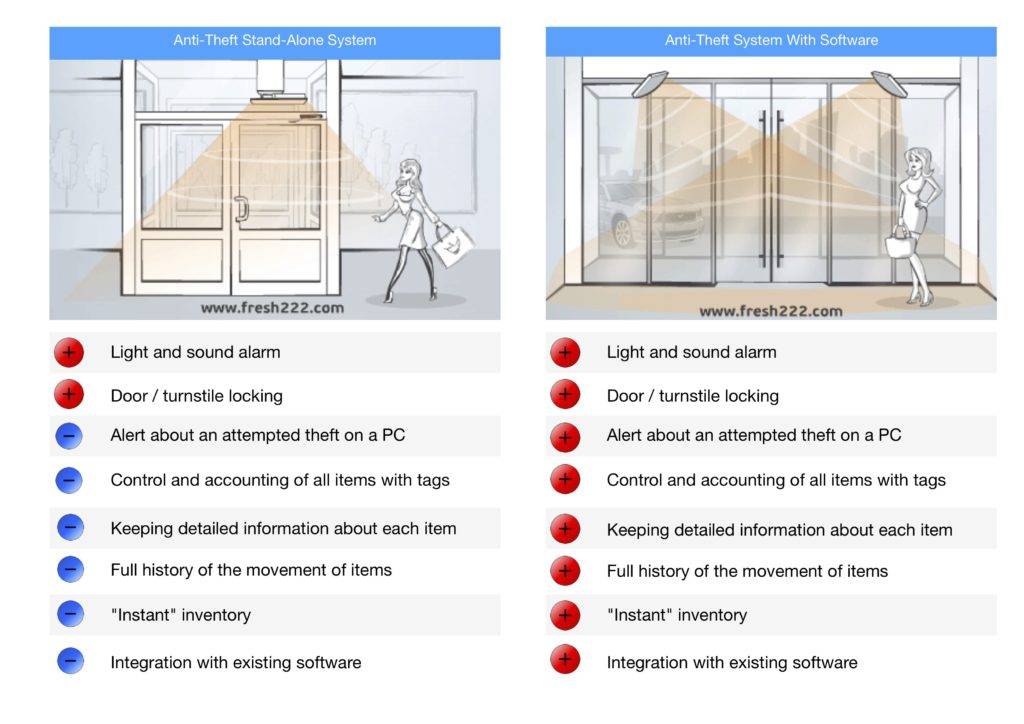
Chicago, Retail Anti-Theft Systems
Retail Theft Prevention Systems
Retail theft is a significant concern for businesses worldwide, resulting in billions of dollars in losses each year. Implementing effective retail theft prevention systems is crucial for protecting merchandise and maintaining profitability. In this article, we’ll explore the various types of retail theft prevention systems and their importance in safeguarding businesses against theft.
Understanding Retail Theft
Retail theft, commonly known as shoplifting, occurs when individuals steal merchandise from retail stores. However, theft in retail environments can also involve employees, vendors, or organized retail crime groups. The stolen items can range from small, high-value items to large, expensive products, leading to substantial financial losses for retailers.
Importance of Retail Theft Prevention Systems
Retail theft prevention systems play a vital role in deterring theft, reducing losses, and maintaining a secure shopping environment. These systems not only help prevent theft but also assist in identifying and apprehending thieves, whether they are customers or employees. By implementing robust theft prevention measures, retailers can protect their merchandise, profits, and reputation.
Types of Retail Theft Prevention Systems
Security Cameras
Security cameras are a cornerstone of retail theft prevention systems. They provide surveillance coverage of store premises, allowing real-time monitoring and recording of activities. The presence of visible security cameras acts as a deterrent to potential thieves and provides valuable evidence in the event of theft incidents.
Electronic Article Surveillance (EAS) Systems
EAS systems utilize tags or labels attached to merchandise. These tags trigger an alarm if someone attempts to remove an item from the store without proper deactivation. EAS systems are effective in deterring theft and are commonly used in retail stores of all sizes.
RFID Technology
RFID (Radio-Frequency Identification) technology is increasingly being used in retail theft prevention. RFID tags embedded in merchandise contain unique identifiers that can be tracked throughout the supply chain. Retailers can use RFID technology for inventory management, loss prevention, and enhancing the overall shopping experience.
Inventory Management Systems
Inventory management systems help retailers track merchandise levels and identify discrepancies that may indicate theft or loss. These systems use advanced technology to monitor inventory movement and provide real-time data on stock levels. By maintaining accurate inventory records, retailers can detect and address theft incidents promptly.
Employee Training and Monitoring
Employee training and monitoring are essential components of retail theft prevention. By educating employees about theft prevention techniques and security protocols, retailers can empower them to identify and report suspicious behavior. Additionally, implementing measures such as employee background checks and surveillance can help deter internal theft.
Benefits of Retail Theft Prevention Systems
Implementing retail theft prevention systems offers numerous benefits, including:
- Reduced losses due to theft
- Improved profitability
- Enhanced customer trust and satisfaction
- Safer shopping environment for both customers and employees
- Better inventory management and control
How Retail Theft Prevention Systems Work
Retail theft prevention systems work by deterring theft, detecting suspicious behavior, and facilitating the apprehension of thieves. Security cameras provide visual surveillance, while EAS systems and RFID technology prevent unauthorized removal of merchandise. Inventory management systems track inventory movement, and employee training and monitoring help prevent internal theft.
Best Practices for Implementing Retail Theft Prevention Systems
- Conduct a thorough risk assessment to identify vulnerabilities and prioritize security measures.
- Invest in high-quality security equipment and technology to ensure effectiveness and reliability.
- Implement strict access controls and monitor employee activities closely.
- Maintain updated inventory records and conduct regular audits to detect discrepancies.
- Collaborate with law enforcement agencies to address theft incidents and apprehend offenders.
Conclusion
Retail theft prevention systems are essential for protecting merchandise, reducing losses, and maintaining a secure shopping environment. By implementing a combination of security measures, including security cameras, EAS systems, RFID technology, inventory management systems, and employee training, retailers can deter theft and ensure the safety and profitability of their businesses.
FAQs
- * How effective are retail theft prevention systems in deterring theft?
- Retail theft prevention systems are highly effective in deterring theft and reducing losses. However, their effectiveness depends on various factors, including the type of system used, implementation strategy, and employee compliance with security protocols.
- * Are retail theft prevention systems expensive to implement?
- The cost of implementing retail theft prevention systems varies depending on the size of the retail operation, the type of systems chosen, and other factors. While there may be upfront costs involved, the long-term benefits typically outweigh the initial investment.
- * Can retail theft prevention systems be integrated with other security systems?
- Yes, many retail theft prevention systems can be integrated with other security systems, such as access control systems and surveillance cameras. This integration enhances overall security and allows for more comprehensive monitoring and control.
- * Do retail theft prevention systems only target external theft?
- No, retail theft prevention systems are designed to address both external and internal theft. In addition to deterring shoplifters, these systems help prevent employee theft and shrinkage, improving overall security and profitability.
- * What steps can retailers take to maximize the effectiveness of their theft prevention systems?
- Retailers can maximize the effectiveness of their theft prevention systems by implementing best practices, such as regular employee training, strict inventory management, and collaboration with law enforcement. Additionally, staying updated on emerging threats and technology trends is crucial for maintaining effective security measures.

